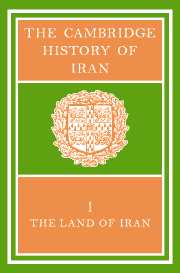12 - EARLY MAN IN IRAN
from PART 2 - THE PEOPLE
Published online by Cambridge University Press: 28 March 2008
Summary
Fossilized remains of early forms of man are rare in all parts of the world, and in this respect the Middle East is no exception. Claims have been made for Africa as the place of origin of humanity; other claims favour an Asian origin. As for the Middle East, “Here was the nursery of modern man (Homo sapiens) in an area equidistant from our two hypothetical cradles, one in Central Asia, the other in East-South Africa”. Field suggests that whilst the first man evolved in an area other than the Middle East–and the weight of the fossil evidence is now very much in favour of an African origin–the Middle East became the area where, in comparatively recent times, his modern form evolved.
Moreover it is virtually certain that the early forms of man, presumably of the Pithecanthropus variety, spread quickly and extensively through the tropical and subtropical areas of the Old World from one of the two proposed areas of origin (Africa or Asia)–and in either case of necessity, via the Middle East. Early human migrations of great importance must therefore have occurred in this area, but as yet there is no fossil evidence from the Middle East as a whole, let alone Iran, for anything but the most limited traces of very early human occupations.
It has been claimed that “Stone Age Man” lived in and migrated across south-west Asia for perhaps 100,000 years, during which time rapid cultural advances occurred. Field further asserts that this was the “Nursery of Man” where Homo sapiens developed, from which he subsequently migrated in every direction, and into which later immigration occurred.
Keywords
- Type
- Chapter
- Information
- The Cambridge History of Iran , pp. 393 - 408Publisher: Cambridge University PressPrint publication year: 1968



